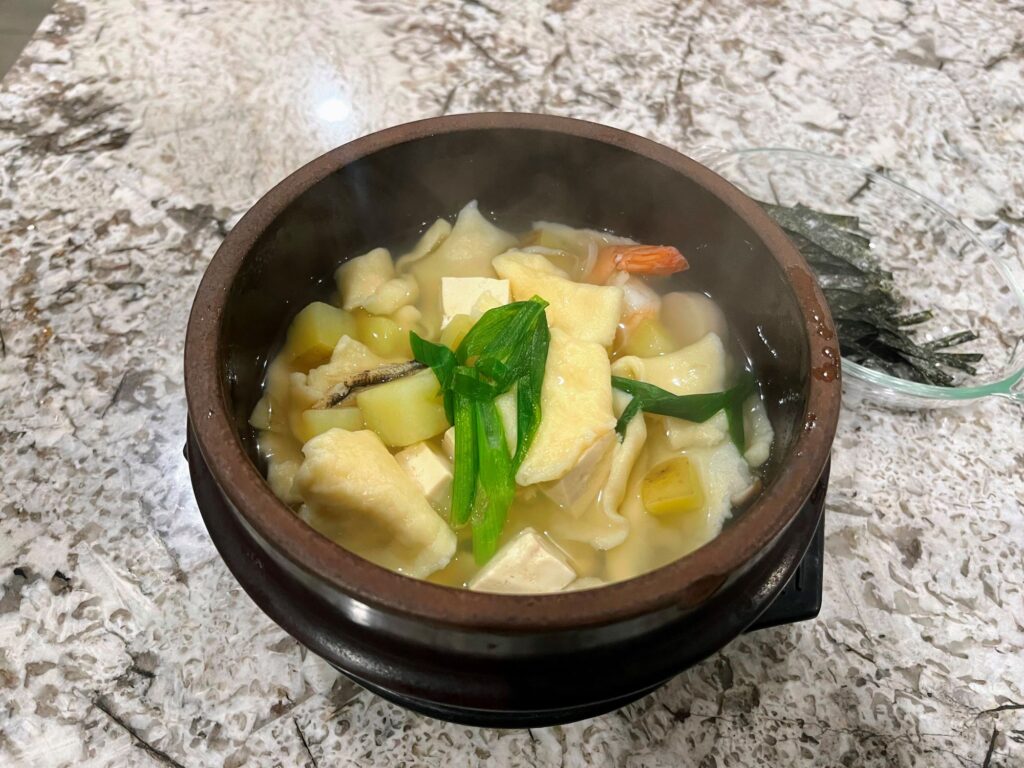Sujebi, a simple yet soul-nourishing Korean dough soup, has been a beloved dish in my family for generations. It holds a special place in our hearts, cherished by my daughters and a reminder of my father’s humble beginnings in Korea. This comforting soup is more than just a meal. It’s a symbol of tradition and love passed down through the years. Let me share this treasured sujebi recipe with you, filled with rich flavors and a deep connection to our heritage.
The Humble Origins of Sujebi
Sujebi, the Korean dough soup, has a long history in Korea, especially during tough times like war and poverty. It was a dish born out of necessity, showing how resourceful Korean cooking can be. When ingredients were scarce, people would use simple staples like flour and water to make a hearty meal.
The name “Sujebi” means “hand-torn noodles,” which refers to the unique texture of the dough, torn by hand into irregular pieces. This simple yet creative dish highlights how Koreans made the most of what they had. It’s also my dad’s favorite dish, and he still enjoys it often, remembering his younger days when it was a comforting, regular meal for him.
Sujebi: A Beloved Korean Comfort Food
Sujebi, the Korean dough soup, has come a long way from its humble beginnings. Over time, people began adding different ingredients like vegetables, seafood, or meat, making the dish richer in flavor and nutrition while keeping its simple roots intact.
Today, Sujebi is a cherished part of Korean culinary tradition. It’s known for turning basic ingredients into a warm, comforting meal that brings families together. Its popularity has only grown across Korea, and you can find it in many markets and restaurants. Loved by people from all walks of life, Sujebi is a dish that beautifully reflects the heart of Korean cuisine.
A Family Favorite
I’ve been making Sujebi, the Korean dough soup, for my children since they were young. Now that they’re in college, they still ask for it whenever they come home. This dish has a special place in our family, especially for my father. He loves Sujebi and eats it 3-4 times a week, as it reminds him of his childhood and simpler times.
Because of its connection to my father, Sujebi has become an important dish in my life too. When I make it for my children, I’ve created a simple and quick sujebi recipe that uses a blender to make the dough easier to prepare.
Sujebi (Korean Dough Soup) with a Twist
Sujebi, the Korean dough soup, shares similarities with another popular dish, Kalguksu, as both use an anchovy-based broth. The key difference in Sujebi is the addition of potatoes, which make the soup thicker. To keep the potatoes intact, it’s best to add them halfway through cooking.
Although I usually avoid meat and dairy, I make an exception for this dish since it’s for my daughters, who aren’t vegan. I include eggs in the dough and add shrimp, which they really enjoy in Sujebi.
For an extra spicy kick, I like to add jalapeño sauce, similar to the way it’s done in Kalguksu. This version of Sujebi is a hit with spice lovers like my daughters. You can also customize it by adding vegetables like carrots, zucchini, mushrooms, or even tofu for extra protein. Give this flavorful recipe a try, and I hope it brings the same comfort and joy to your family that it has brought to ours over the years.
Sujebi (Korean Dough Soup) Recipe
Yields 3 servings

Ingredients
For the soup:
- 2 small potatoes or 1 large potato, peeled and cubed
- 4-5 shrimps (optional)
- 4-5 raw clams (optional)
- 1 cloves of garlic minced
- 2 tsp salt
- 6 cups water
- 3 dried anchovies (for broth)
- Green onions (for garnish)
- Optional: 1 sheet of plain dry seaweed, cut into thin strips (for garnish)
For the dough:
- 320g flour (about 2 1/2 cups)
- 2 tbsp corn starch
- 1 tsp salt
- 2/3 cup water
- 1 egg
- 1 tsp olive or vegetable oil
Optional Jalapeno Sauce:
- 1/4 tsp Korean red pepper
- 1 1/2 tbsp soy sauce
- 1 tsp sesame oil
- 2 chopped jalapenos (to taste)
Instructions
1. Prepare the Anchovy Broth
The first step in making Sujebi, the Korean dough soup, is to prepare the anchovy broth or use vegan broth. Bring 6 cups of water to a boil in a large pot. Add dried anchovies, minced garlic, and salt. Let it simmer for 10-15 minutes or longer to let the flavors infuse. Once done, remove the anchovies from the broth.
2. Make the Dough
For the dough, use a food processor with a dough blade. Add the dough ingredients and blend for about 2 minutes until the dough forms a slightly sticky, stretchy ball. Let the dough rest for 10-15 minutes to let the flavors meld.
3. Cook the Potatoes and Clams
If you’re adding clams, put them into the broth along with the potatoes. Let it simmer for about 10 minutes, or until the potatoes are just tender.
4. Prepare the Dough Pieces
While the broth is simmering, break the dough into small portions. Stretch and flatten each piece with your fingers, then drop them into the simmering broth. Stir occasionally to prevent the dough from sticking.
5. Add Shrimp (Optional)
If you’re adding shrimp to your sujebi (Korean dough soup), drop them into the soup a few minutes before it’s finished. Let them cook until they turn pink.
6. Season and Adjust
Taste the soup and add salt as needed to suit your taste.
7. Make Jalapeño Sauce (Optional)
For some extra flavor, you can make a jalapeño sauce. In a small bowl, mix Korean red pepper, soy sauce, sesame oil, and chopped jalapeños.
8. Serve
Once everything is ready, serve your Sujebi (Korean dough soup) hot! Top it with chopped green onions and seaweed if you like. For extra spice, drizzle the optional jalapeño sauce on top before serving.
Storing and Reheating Leftover Sujebi
Leftover Sujebi, the Korean dough soup, can be stored in the fridge and eaten the next day, but the texture may change. The dough might soak up more soup, making it softer or a little mushy when reheated. While it’s still good to eat, Sujebi tastes best when freshly made. If you plan to keep leftovers, store the dough and broth separately until you’re ready to heat them up.
If you have extra dough, you can wrap it in plastic and freeze it for later. Just thaw it overnight in the fridge when you want to use it, making it easy to prepare Sujebi whenever a craving hits.
And don’t forget to serve your Sujebi with some kimchi! A side of radish or cabbage kimchi will complete the meal for an authentic Korean experience. Enjoy!














